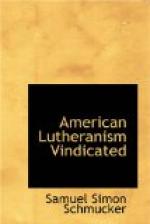To this decided declaration of Melancthon, we might add his assertions on other occasions. Let a single one suffice. In his letter to Margrave George, of Brandenburg, on the private mass, he uses this language: “Finally, as your excellence wishes to know what we retain in our churches of the ceremonies of the mass, I would inform your excellence, that the mass is entirely abolished, except when are persons present who wish to receive the Lord’s Supper;” [Note 37] that is, we have entirely abolished private masses; at which, as it is well known, no one communed but the priest himself, but retain the public mass at communion seasons.
Finally, to make assurance doubly sure, we will add a similar testimony from Luther himself, in a letter of Counsel to Lazarus Spengler, in 1528: “In the first place, let all masses be absolutely dispensed with at which there are no communicants present; as they properly ought to be set aside. Secondly, that in the two parish churches (namely, in Nuerenberg, where Spongier resided,) one or two masses should be held on Sabbath and holy days, according as there may be many or few communicants.” [Note 38]
Now, in this passage, the word mass either means Lord’s Supper in general or mass in particular. It does not mean the former, because it was something which Luther says had been performed without any communicants being present, but should not be performed hereafter, unless there were communicants. Again, he says, that on Sabbath or holy days, when there are communicants present, this mass, which from its nature could be and had been performed without communicants, should be performed once or twice. But what sense is there in terming that the administration of the Lord’s Supper at which there are no communicants. Or in talking about administering one or two Lord’s Suppers, as the number of communicants might be large or small? For ourselves, it is impossible to doubt, that the mass proper is here intended, which was often celebrated by the minister alone, and which, at communion seasons, was the usual preparation for the communion.
And now, what is the result of our inquiry?
We premised, as conceded by all, that as the word mass among the Romanists does now, so it did at the time of the the [sic] Reformation, and several centuries before, specifically signify a certain service of about an hour’s length, consisting of a commixture of Scripture passages, long and short prayers, invocations, extracts from the gospels and epistles, liturgic forms, the forms of consecration of the elements and transubstantiation of them into the Saviour’s body and blood, with numerous crossings, genuflexions, the elevation of the host and especially the self-communion of the priest, as an offering of the body of Christ a bloodless sacrifice for the sins of the living or dead; all of which was read and done by the priest himself before the altar; and which preceded the sacramental communion of the congregation, and was the only preparation for the communion.




